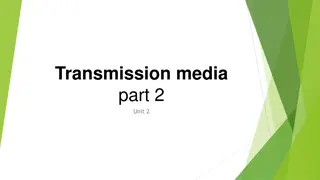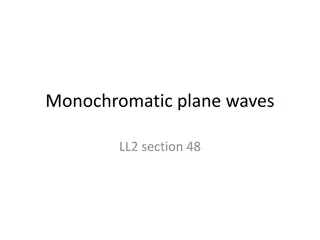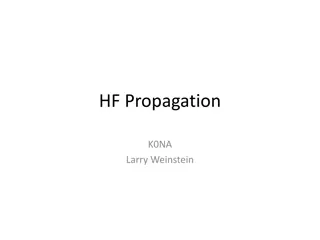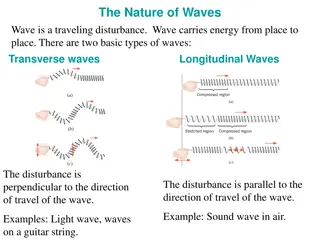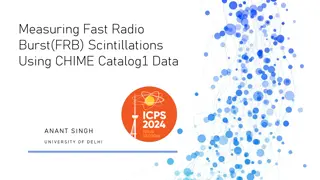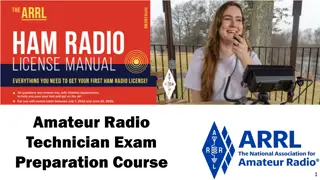Understanding Weak Signal Propagation in Radio Waves
This informative content delves into weak signal propagation and its various aspects related to electromagnetic waves, particularly in the context of radio communication. It covers topics such as radio waves, radio horizon, knife-edge diffraction, tropospheric scatter mode, auroral reflection, and meteor scatter. Additionally, it explores the layers of the ionosphere and how they impact radio wave propagation. The content provides insights into how different conditions and phenomena affect signal transmission and reception in the realm of radio waves.
Download Presentation

Please find below an Image/Link to download the presentation.
The content on the website is provided AS IS for your information and personal use only. It may not be sold, licensed, or shared on other websites without obtaining consent from the author. Download presentation by click this link. If you encounter any issues during the download, it is possible that the publisher has removed the file from their server.
E N D
Presentation Transcript
Technician Licensing Class Weak Signal Propagation Section 15 Valid July 1, 2014 Through June 30, 2018
Weak Signal Propagation T5C07 Radio waves is a usual name for electromagnetic waves that travel through space. Electromagnetic waves are RADIO WAVES
Weak Signal Propagation T3C10The distance at which two stations can communicate by direct path is the radio horizon. VHF & UHF radio signals will generally travel line of sight. VHF & UHF radio signals are blocked by the curvature of the Earth. T3C11 Signals travel somewhat farther than the visual line of sight because the Earth seems less curved to radio waves than to light
Weak Signal Propagation T3C05 The effects of knife-edge diffraction causes radio signals to be heard despite obstructions between the transmitting and receiving stations. Knife-Edge Diffraction
Weak Signal Propagation T3C06Tropospheric scatter modeis responsible for allowing over-the-horizon VHF and UHF communications to ranges of approximately 300 miles on a regular basis. T3C08Temperature inversions in the atmosphere causes "tropospheric ducting". Tropospheric Ducting
Weak Signal Propagation T3C03A characteristic of VHF signals received via auroral reflection is that the signals exhibit rapid fluctuations of strength and often sound distorted. Incoming signals from a distant station heard hundreds of miles away will sound fluttery and distorted by auroral bounce
Weak Signal Propagation T3C07The 6 meter band is best suited to communicating via meteor scatter. Leonids and Geminids meteor showers provide these conditions Bounce signals off meteor tail
Weak Signal Propagation Basically five layers: D, E, F, F1, and F2. Differences in Day-time and Night-time: D and E disappear at night. F1 and F2 combine at night to become just F. 8 8 Ionosphere Layers
Weak Signal Propagation T3A11The ionosphere is the part of the atmosphere that enables the propagation of radio signals around the world. T3C09During daylight hours (dawn to shortly after sunset) is generally the best time for long-distance 10 meter band F-layer propagation.
Weak Signal Propagation T3C02 When VHF signals are being received from long distances these signals are being refracted from a sporadic E layer. Sporadic-E refractions off ionized patches of the ionospheric E- layer are common in summer on 6-meters.
Weak Signal Propagation T3C04Sporadic E propagation is most commonly associated with occasional strong over-the-horizon signals on the 10, 6, and 2 meter bands. T3C01UHF signals "direct" (not via a repeater) are rarely heard from stations outside your local coverage area because UHF signals are usually not reflected by the ionosphere. T3A08The cause of irregular fading of signals from distant stations during times of generally good reception is due to random combining of signals arriving via different path lengths.
Weak Signal Propagation T3A09A common effect of "skip" reflections between the Earth and the ionosphere is the original signal becomes randomized or elliptically polarized. Either vertically or horizontally polarized antennas may be used for transmission or reception. Skip happens when signals refract and reflect off the ionosphere. DX stations 1000 miles away come booming in. Every 30 seconds signal goes from strong to weak and back. Caused by random, ever changing polarization of the original signal.
Weak Signal Propagation T3C12The Six or Ten meter bands may provide long distance communications during the peak of the sunspot cycle. T3B02 The orientation of the electric field is the property of a radio wave is used to describe its polarization.
Take Aways A usual name for electromagnetic waves that travel through space is Radio waves. The radio horizon is the distance at which two stations are effectively blocked by the curvature of the earth. VHF and UHF radio signals usually travel somewhat farther than the visual line of sight distance between two stations because the Earth seems less curved to radio waves than to light.
Take Aways The term knife-edge diffraction refers to signals that are partially refracted around solid objects exhibiting sharp edges. This allows radio signals to be heard despite obstructions between the transmitting and receiving stations, Tropospheric scatter mode is responsible for allowing over- the-horizon VHF and UHF communications to ranges of approximately 300 miles on a regular basis. Tropospheric ducting is caused by temperature inversions in the atmosphere. Signals exhibiting rapid fluctuations of strength and often sounding distorted is a characteristic of VHF signals received via auroral reflection
Take Aways The 6 meter band is best suited to communicating via meteor scatter. The part of the atmosphere called the ionosphere enables the propagation of radio signals around the world. When VHF signals are being received from long distances signals are possibly being refracted from a sporadic E layer in the atmosphere. Generally, the best time for long-distance 10 meter band propagation is during daylight hours during periods of high sunspot activity.
Take Aways A common effect of "skip" reflections between the Earth and the ionosphere is the original signal is elliptically polarized and either vertically or horizontally polarized antennas may be used for transmission or reception. The Sporadic E propagation type is most commonly associated with occasional strong over-the-horizon signals on the 10, 6, and 2 meter bands. Direct UHF signals (not via a repeater) are rarely heard from stations outside your local coverage area because UHF signals are usually not reflected by the ionosphere.
Take Aways Random combining of signals arriving via different paths is the cause of irregular fading of signals from distant stations during times of generally good reception. The Six or Ten meter bands may provide long distance communications during the peak of the sunspot cycle. The orientation of the electric field is the property of a radio wave is used to describe its polarization.
Element 2 Technician Class Question Pool Weak Signal Propagation Valid July 1, 2014 Through June 30, 2018
T5C07What is a usual name for electromagnetic waves that travel through space? A. Gravity waves B. Sound waves C. Radio waves D. Pressure waves 21
T3C10What is the radio horizon? A. The distance over which two stations can communicate by direct path B. The distance from the ground to a horizontally mounted antenna C. The farthest point you can see when standing at the base of your antenna tower D. The shortest distance between two points on the Earth's surface 22
T3C11 Why do VHF and UHF radio signals usually travel somewhat farther than the visual line of sight distance between two stations? A. Radio signals move somewhat faster than the speed of light B. Radio waves are not blocked by dust particles C. The Earth seems less curved to radio waves than to light D. Radio waves are blocked by dust particles 23
T3C01 Why are direct (not via a repeater) UHF signals rarely heard from stations outside your local coverage area? A. They are too weak to go very far B. FCC regulations prohibit them from going more than 50 miles C. UHF signals are usually not reflected by the ionosphere D. They collide with trees and shrubbery and fade out 24
T3C05 Which of the following might cause radio signals to be heard despite obstructions between the transmitting and receiving stations? A. knife-edge diffraction B. Faraday rotation C. Quantum tunneling D. Doppler shift 25
T3C06 What mode is responsible for allowing over-the- horizon VHF and UHF communications to ranges of approximately 300 miles on a regular basis? A. Tropospheric scatter B. D layer refraction C. F2 layer refraction D. Faraday rotation 26
T3C08What causes tropospheric ducting? A. Discharges of lightning during electrical storms B. Sunspots and solar flares C. Updrafts from hurricanes and tornadoes D. Temperature inversions in the atmosphere 27
T3C03 What is a characteristic of VHF signals received via auroral reflection? A. Signals from distances of 10,000 or more miles are common B. The signals exhibit rapid fluctuations of strength and often sound distorted C. These types of signals occur only during winter nighttime hours D. These types of signals are generally strongest when your antenna is aimed west 28
T3C07 What band is best suited to communicating via meteor scatter? A. 10 meters B. 6 meters C. 2 meters D. 70 cm 29
T3A11 Which part of the atmosphere enables the propagation of radio signals around the world? A. The stratosphere B. The troposphere C. The ionosphere D. The magnetosphere 30
T3C02 Which of the following might be happening when VHF signals are being received from long distances? A. Signals are being reflected from outer space B. Signals are arriving by sub-surface ducting C. Signals are being reflected by lightning storms in your area D. Signals are being refracted from a sporadic E layer 31
T3C09 What is generally the best time for long-distance 10 meter band propagation via the F layer? A. From dawn to shortly after sunset during periods of high sunspot activity B. From shortly after sunset to dawn during periods of high sunspot activity C. From dawn to shortly after sunset during periods of low sunspot activity D. From shortly after sunset to dawn during periods of low sunspot activity 32
T3A09 Which of the following results from the fact that skip signals refracted from the ionosphere are elliptically polarized? A. Digital modes are unusable B. Either vertically or horizontally polarized antennas may be used for transmission or reception C. FM voice is unusable D. Both the transmitting and receiving antennas must be of the same polarization 33
T3C04 Which of the following propagation types is most commonly associated with occasional strong over- the-horizon signals on the 10, 6, and 2 meter bands? A. Backscatter B. Sporadic E C. D layer absorption D. Gray-line propagation 34
T3C12 Which of the following bands may provide long distance communications during the peak of the sunspot cycle ? A. Six or ten meters B. 23 centimeters C. 70 centimeters or 1.25 meters D. All of these choices are correct 35
T3B02 What property of a radio wave is used to describe its polarization? A. The orientation of the electric field B. The orientation of the magnetic field C. The ratio of the energy in the magnetic field to the energy in the electric field D. The ratio of the velocity to the wavelength 36
T3A08 Which of the following is a likely cause of irregular fading of signals received by ionospheric reflection? A. Frequency shift due to Faraday rotation B. Interference from thunderstorms C. Random combining of signals arriving via different path lengths D. Intermodulation distortion 37






